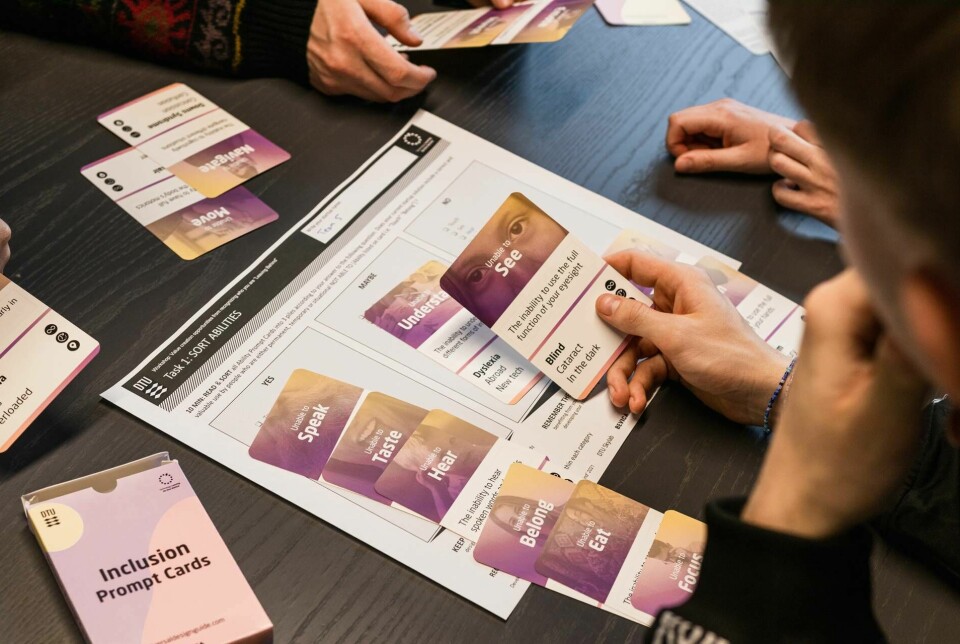Researchers' Zone:

Engineers need to ensure that everyone is invited to the party
"No one should be excluded from society," is one of the Sustainable Development Goals. Therefore, engineers should prioritize all individuals, regardless of abilities and needs.
We all know the feeling of being left behind, whether it was not being invited to a birthday party or being picked last for the handball team, right?
So, imagine being left behind by many important areas of society, both physical and digital – how awful must that feeling be?
At The Technical University of Denmark (DTU) we educate the engineers of the future. They have a big influence on how our society is designed and constructed in the upcoming decades.
I took that as a challenge because it is a great responsibility. That is why my colleagues and I at DTU Skylab – the innovation hub of DTU – decided to create a program called ‘Technology Leaving No One Behind’, inspired by UN’s development goals (see box).
User involvement gives a reality check
Traditionally, students at technical universities focus on developing technologies and solving problems, and are in fact, very good at it.
However, focus on the actual people that will use the buildings, technologies, systems, or services they design, can sometimes be lost in the innovation process.
One of the minority groups that is most often ‘left behind’ is people with disabilities.
This includes wheel chair users, people who have muscular dystrophy, people with visual impairment, but also people that have invisible disabilities, such as dyslexia, autism and ADHD.
This is not because of ill will. As humans it is often very natural to ‘only’ consider what we are familiar with when we are designing solutions – we design for ourselves.
Examples of designs that exclude are seen across many different domains of technologies, including digital design for facial analysis, car safety and modern medicine.
That is why in ‘Technology Leaving No One Behind’ we have chosen to put all our efforts into doing a lot of activities, such as events and workshops with our engineering students where we also invite real end-users with diverse disabilities to help co-create the solutions of tomorrow.
This way our students can improve their innovations by learning about experiences and perspectives that are different from their own.

Design tools as another reality check
An important part of our work is that we create concrete tools and methods that our engineering students can use in their project work to help them learn how to design more inclusive solutions.
We have for example developed a website called Universal Design Guide where our students, and everyone else, can find great design methods that help you design inclusive co-creation workshops.
These methods include assumption dumption, bodystorming and ability prompt cards – we will return to the latter in a moment.
Our goal with this online support tool is to connect with a large and diverse group of students, teachers, and even professionals, beyond the walls of the university.
We, at Technology Leaving No One Behind, are driven by a shared desire to change the way engineers approach innovation, using the qualities of design thinking and empathy-building methods found in the Universal Design Guide.

Prompt cards to build empathy
We also provide a large amount of information on the website about universal design and the reason for why it is so important for our society.
The website has many clever functions and a lot of useful information for anyone that is curious about universal design, inclusion and how we can create inclusive innovation processes.
One of the most popular tools on our website is called the ‘Ability Prompt Cards’, which is a tool intended to build empathy and to challenge us to think about how innovations can work for a broader group of people.
In inclusive design it is a tradition to work with for example personas, a useful tool to be able to understand end-users that for example have a disability.
Influenced by this long-standing tradition, we have taken a unique approach. Instead of focusing solely on the persona, we chose to extract abilities and corresponding disabilities, which is where the cards get their name from.
In a way, we all got a certain set of abilities, that may vary through life and situations. The cards therefore focus on 16 of these core abilities and provide examples of how they can vary through life.
One card is the ability to touch – setting focus on the ability to use the full function of both your hands.
This ability may vary throughout life and in different situations, you may be born with only one arm, be temporary unable to use one hand because of an injury or find yourself in situations where you are carrying a baby and therefore also only have one arm to use.
Constraints increase creativity
We use each card as a constraint, to guide for example brainstorms, prompting us to confront our biases, or to assess ideas and solutions.
Research has demonstrated that constraints can increase creativity which is why we believe that using the cards as constraints can enable more creative and more inclusive solutions.
Designing for people with permanent disabilities can seem like a significant constraint, but can in fact result in solutions that can benefit a much larger number of people.
Also, when we use the cards to prompt for whether an idea is excluding people with certain disabilities, we use the mindset of considering ourselves as either temporary users, such as if we were to break a leg, or future users.
If anything is certain, it is that we are all aging as we speak.
We can all be part of the change
All in all, the work that we do with universal design and inclusion has been very well received amongst our students and staff, which is very motivating as it shows that people are interested in being more inclusive.
I’m also very motivated by the fact that we have already had a great impact on the university’s goal of creating ‘technology for people’ and on the ambition to fulfill the United Nations goal of ‘Leaving no one behind’.
Why? Because I believe, inclusion is such an important element in our society.
I hope for a continued success of creating inclusive mindsets, success of education about universal design and inclusion, and ultimately the success of an up-and-coming generation of students who will have an inclusive mindset ingrained into their practice in, and for society.
I believe we should all ask ourselves the question: How can universal design be part of shaping a society that is inclusive for all? And how can we design solutions for real, not ideal people?
DTU’s ‘Technology Leaving No One Behind’ is done in partnership with The Danish association of Youth With Disabilities (SUMH), Disabled People's Organisations Denmark (DPOD), DTU Entrepreneurship, DTU Management and Bevica Fonden.





